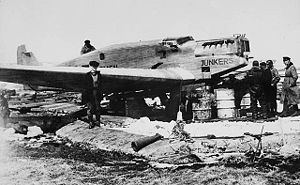Manufacturer Junkers | ||
 | ||
The Bremen is a German Junkers W 33 aircraft that made the first successful transatlantic aeroplane flight from east to west on April 12 and 13, 1928.
Contents
After weather delays lasting 17 days, the Bremen left Baldonnel Aerodrome, Ireland, on April 12 and flew to Greenly Island, Canada, arriving on April 13, after a flight fraught with difficult conditions and compass problems.
The crew was to be all-German. Ehrenfried Günther Freiherr von Hünefeld, a wealthy German aristocrat, and pilot Captain Hermann Köhl had made an attempted crossing together in 1927, but had to abandon it due to bad weather. For this new attempt, they enlisted as the navigator, Major James Fitzmaurice, of Ireland. Fitzmaurice had also attempted a previous crossing as co-pilot of the Princess Xenia with Robert McIntosh, but they had to abandon the attempt due to high headwinds in September 1927.
Flight log
Landing
Greenly Island is small, barren and rocky. It was fortunate for the crew that the airplane landed in a peat bog. The relatively soft landing saved them but damaged the plane.
The clock in the lighthouse was remembered (by the family of the lighthouse keeper) as indicating 2 p.m. Atlantic Time when the Bremen was first sighted from the ground. Captain Köhl and Baron von Hünefeld said that they were in the air 36½ hours. If their statements of elapsed time had an accuracy of better than one minute, which is unlikely, then the time of touchdown was 18:08 GMT or 13:08 EST or 14:08 Atlantic Time.
Gretta May Ferris, a nurse from Saint John, New Brunswick, who was posted at nearby Forteau's Grenfell Medical Station, travelled by dogsled some 15 miles (24 km) to attend to the crew's medical needs; she was the first to write the story that was picked up by the international media saying that the Bremen had landed and that the crew were safe.
Alfred Cormier of Long Point (Lourdes-de-Blanc-Sablon), who operated the local telegraph office from his home, made contact with Marconi station VCL at Point Amour in Labrador—18 miles (29 km) east of Long Point. From there, his message went through St. John's, Newfoundland (at 6:30 p.m.) and Louisbourg, Nova Scotia. It was forwarded by land lines across Canada and via Radio Corporation of America (RCA) station WCC at Chatham, Massachusetts, for transmission to New York City.
The first message read: "German plane at Greenly Island, wind southeast, thick [fog]."
A short time later, a second message was sent: "German plane Bremen landed Greenly Island, noon, slightly damaged, crew well."
By 7:15 p.m., the story was in all the newsrooms of the eastern seaboard.
The first Canadian aircraft to reach the scene was piloted by Duke Schiller and the second machine was flown by the Canadian Transcontinental Airways Company's Chief Pilot, Romeo Vachon, who arrived two days later with a group of media representatives. Both Schiller and Vachon were flying Fairchild FC-2W machines; G-CAIQ (Schiller) and G-CAIP (Vachon). Ultimately, some 60 journalists would crowd onto the island to report on the successful crossing. The Bremen crew did not depart the island for two weeks as they attempted to repair the aircraft, but they were ultimately unsuccessful. On their arrival in New York on April 30, the crew were honoured with a tickertape parade.
On 2 May, the 70th United States Congress authorized President Calvin Coolidge, to confer the United States Distinguished Flying Cross on the fliers. Back in Ireland on 30 June 1928, they were bestowed the Freedom of the City of Dublin in recognition of their trans-Atlantic flight achievement
Later in 1928 they published a book about their experience called (in English) The Three Musketeers of the Air.
Status
The Bremen belongs to the Henry Ford Museum in Dearborn, Michigan, and is currently on display in a hangar at the Bremen Airport Museum, where it has been completely restored.
